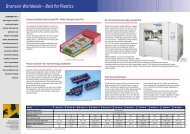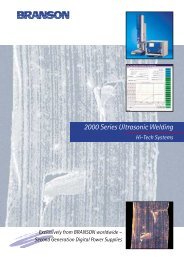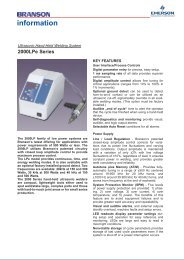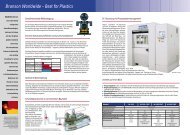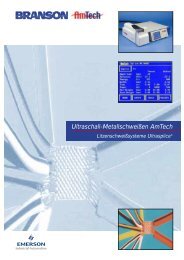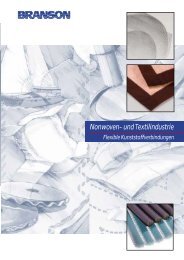Process Controller 2000mc net
Process Controller 2000mc net
Process Controller 2000mc net
You also want an ePaper? Increase the reach of your titles
YUMPU automatically turns print PDFs into web optimized ePapers that Google loves.
<strong>Process</strong> <strong>Controller</strong> <strong>2000mc</strong> <strong>net</strong> with Power Supply<br />
Digital Compact DC<br />
Optional Data Management with statistics<br />
package - The powerful access-based program<br />
has been designed for saving, evaluating<br />
and archiving welding data (online/offline), as<br />
well as for integration into company <strong>net</strong>works,<br />
easy data exchange and online support.<br />
Selective deactivation of individual channels<br />
- An advantageous tool for editing parameters<br />
offline and servicing components.<br />
Diverse process control options can be<br />
accessed:<br />
Amplitude and Force Profiling - Both methods<br />
control the joining process, using presets<br />
determined by empirical knowledge. They indirectly<br />
ensure optimal welding conditions, leading<br />
to controlled melting in the welding zone.<br />
In the case of Amplitude Profiling (pat.),<br />
the process controller reduces the amplitude<br />
of the horn after certain set values have<br />
been reached (welding time, distance, energy,<br />
peak power level), consequently reducing the<br />
required plastification energy during the residual<br />
time. Amplitude profiling is suited to amorphous<br />
thermoplastics.<br />
In the case of Force Profiling welding usually<br />
commences with a high energy. Subsequently,<br />
after a preset time interval in the millisecond<br />
range, it is significantly reduced. The energy<br />
being applied to the welding seam is thus<br />
lowered, which leads to controlled melting of<br />
plastic in the joint area. The force profile is<br />
recommended in the case of partially crystalline<br />
thermoplastics.<br />
Energy Mode - Welding with preset energy<br />
level and adjustable threshold monitoring.<br />
Time Mode - Welding with preset time and<br />
adjustable threshold monitoring.<br />
Peak Power Mode - Welding with preset<br />
power level and adjustable threshold<br />
monitoring.<br />
Metal Contact Mode - Welding until metal<br />
contact is achieved and adjustable hold time.<br />
Collapse Distance Mode - The welding distance<br />
is only registered after a reference value<br />
- the preset trigger force - has been reached.<br />
Absolute Distance Mode - The complete<br />
down travel of the fixing tool actuator is<br />
measured.<br />
Optional Ramps - They optimise the force<br />
increase within the welding process.<br />
<strong>Process</strong> <strong>Controller</strong> <strong>2000mc</strong> <strong>net</strong> with external monitor and<br />
Power Supply 2000b<br />
BRANSON ULTRASCHALL · Waldstraße 53-55 · D-63128 Dietzenbach · Telefon (0 60 74) 497-0 · Telefax (0 60 74) 497-199<br />
Inter<strong>net</strong>: www.branson.de · E-mail: info@branson.de<br />
CH Tel. (022) 3 04 83 40, Fax (022) 3 04 83 59 · DK Tel. (032) 51 32 33, Fax (032) 51 51 39 · E Tel. (93) 5 86 05 00, Fax Tel. (93) 5 88 22 58 · F Tel. (01) 41 80 25 50, Fax (01) 46 87 87 29<br />
GB Tel. (01753) 486980, Fax (01753) 486995 · I Tel.(02) 66 08 17.1, Fax (02) 66 08 17 97 · NL Tel. (035) 6 09 81 11, Fax (035) 6 09 81 20<br />
05/04 / Subject to change without notice



